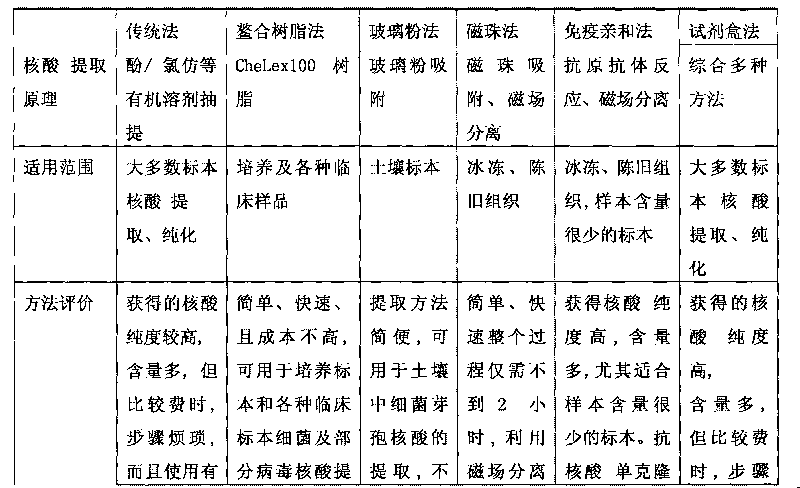High-efficiency extracting method of food-borne pathogen nucleic acid
A technology of food-borne pathogenic bacteria and extraction method, which is applied in the field of efficient nucleic acid extraction of food-borne pathogenic bacteria, can solve the problems of time-consuming nucleic acid extraction and purification, slowing down the detection speed, and cumbersomeness, and achieves the elimination of food and culture. Interference of base components, high purity, high yield effect
- Summary
- Abstract
- Description
- Claims
- Application Information
AI Technical Summary
Problems solved by technology
Method used
Image
Examples
Embodiment 1
[0024] A method for efficiently extracting nucleic acids from food-borne pathogenic bacteria, the composition of which includes: centrifuging the bacterial culture solution, adding buffer A to the centrifuged sediment, shaking and adding lysozyme, adding proteinase K after incubation, adding buffer B, shaking vigorously Afterwards, incubate at a temperature of 65°C for 10 minutes to make a lysis solution, pass through the silicon matrix SiO 2 The adsorption membrane of the material collects high-quality nucleic acid extraction nucleic acid solution.
Embodiment 2
[0026] In the method for efficiently extracting nucleic acid from food-borne pathogenic bacteria, the centrifugation of the bacterial culture solution is to centrifuge 1-5 mL of the bacterial culture solution at a speed of 8,000 rpm for 5 minutes, and suck up the supernatant.
Embodiment 3
[0028] The method for efficiently extracting nucleic acids from food-borne pathogenic bacteria includes adding buffer A to the centrifuge, shaking and adding lysozyme, adding proteinase K after incubation, adding buffer B, and shaking vigorously at temperature Incubate at 65°C for 10 minutes to prepare a lysis solution: add 250 μL of buffer A to the bacterial pellet: 20 mol / L TrisHCl, 2 mol / L EDTA, 1.2% polyethylene Diol octylphenyl ether Triton, shake until the cells are completely suspended, add lysozyme at a final concentration of 20mg / mL, incubate at 37°C for 30 minutes, add 20μL of proteinase K at a concentration of 20mg / mL to the tube Solution, mix well, then add 200 μL buffer B: 0.05mol / L TrisHCl, 0.1mol / L sodium chloride NaCI with pH 7.6, 0.05mol / L EDTA, 2% Sodium dodecyl sulfate SDS, after vigorous shaking, incubated at a temperature of 65°C for 10 minutes.
PUM
 Login to View More
Login to View More Abstract
Description
Claims
Application Information
 Login to View More
Login to View More - R&D
- Intellectual Property
- Life Sciences
- Materials
- Tech Scout
- Unparalleled Data Quality
- Higher Quality Content
- 60% Fewer Hallucinations
Browse by: Latest US Patents, China's latest patents, Technical Efficacy Thesaurus, Application Domain, Technology Topic, Popular Technical Reports.
© 2025 PatSnap. All rights reserved.Legal|Privacy policy|Modern Slavery Act Transparency Statement|Sitemap|About US| Contact US: help@patsnap.com


